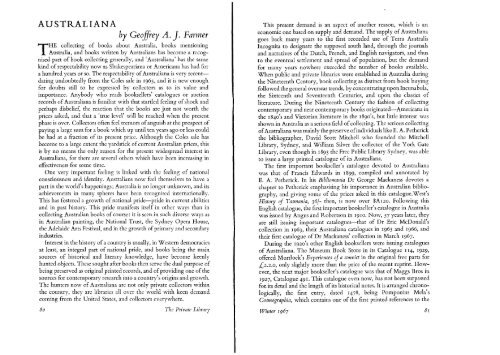Vol 8 Number 4 - The Private Libraries Association
Vol 8 Number 4 - The Private Libraries Association
Vol 8 Number 4 - The Private Libraries Association
Create successful ePaper yourself
Turn your PDF publications into a flip-book with our unique Google optimized e-Paper software.
AUSTRALIANA<br />
by Geo8eY<br />
A. 1. Farmer<br />
HE collecting of books about Australia, books mentioning<br />
T Australia, and books written by Australians has become a rccognised<br />
part of book collecting gencrally, and 'Australiana' has the same<br />
kind of respectability now as Shakespeariana or Americana has had for<br />
a hundred years or so. <strong>The</strong> respectability of Australiana is very recentdating<br />
undoubtedly from thc Coles sale in 1965, and it is new enough<br />
for doubts still to be expressed by collectors as to its value and<br />
importance. Anybody who reads booksellers' catalogues or auction<br />
records of Australiana is familiar with that startled feeling of shock and<br />
perhaps disbelief, the reaction that the books are just not worth the<br />
prices asked, and that a 'true level' will be reached when the prcsent<br />
phase is ovcr. Collectors often fcel tremors of anguish at the prospcct of<br />
paying a large sum for a book which up until ten years ago or lcss could<br />
be had at a fraction of its prcsent price. Although the Coles sale has<br />
become to a large extent the yardstick of current Australian prices, this<br />
is by no means the only reason for the present widcspread interest in<br />
Australiana, for there are scvcral othcrs which have bccn increasing in<br />
effectiveness for somc time.<br />
One very important feeling is linkcd with the feeling of national<br />
consciousness and identity. Australians now fcel themselves to have a<br />
part in the world's happcnings; Australia is no longer unknown, and its<br />
achievements in inany spheres have becn recogniscd internationally.<br />
This has fostercd a growth of national pride-pride in current abilities<br />
and in past history. This pridc manifests itself in other ways than in<br />
collecting Australian books of course: it is sccn in such diverse ways as<br />
in Australian painting, the National Trust, the Sydney Opera House,<br />
the Adelaide Arts Festival, and in the growth of primary and secondary<br />
industrics.<br />
Interest in the history of a country is usually, in Wcstern democracies<br />
at least, an integral part of national pride, and books being the main<br />
sources of historical and literary knowledge, have become keenly<br />
hunted objects. <strong>The</strong>se sought after books then serve the dual purpose of<br />
being preserved as original printed rccords, and of providing one of the<br />
sources for contemporary rescarch into a country's origins and growth.<br />
<strong>The</strong> hunters now of Australiana are not only private collectors within<br />
the country, they are librarics all over the world with keen demand<br />
coming from thc United States, and collectors cverywhere.<br />
This present demand is an aspect of another reason, which is an<br />
economic one based on supply and denland. <strong>The</strong> supply of Australiana<br />
goes back many years to the first recorded use of Terra Australis<br />
Incognita to designate the supposed south land, through the journals<br />
and narratives of the Dutch, French, and English navigators, and thus<br />
to the eventual settlement and spread of population, but the demand<br />
for many years nowhere excccded the numbcr of books available.<br />
When public and private librarics were established in Australia during<br />
the Nineteenth Ccntury, book collecting as distinct from book buying<br />
followed the general overseas trends, by concentrating upon Incunabula,<br />
the Sixteenth and Seventeenth Centuries, and upon the classics of<br />
literature. During the Nineteenth Century the fashion of collecting<br />
contemporary and near contemporary books originated-Americana in<br />
the 1840's and Victorian literature in the 18go's, but little interest was<br />
shown in Australia as a serious field of collecting. <strong>The</strong> serious collecting<br />
of Australiana was mainly the preserve of individuals like E. A. Pethcrick<br />
the bibliographer, David Scott Mitchell who founded thc Mitchcll<br />
Library, Sydney, and William Silver the collector of the York Gate<br />
Library, even though in 1893 the Free Public Library Sydney, was able<br />
to issue a large printed catalogue of its Australiana.<br />
<strong>The</strong> first important bookseller's catalogue devotcd to Australiana<br />
was that of Francis Edwards in 1899, compiled and annotated by<br />
E. A. Petherick. In his Bibliomania Dr George Mackaness devotes a<br />
chapter to Petherick emphasising his importance in Australian bibliography,<br />
and giving some of the prices asked in this catalogue.Wcst's<br />
History of Tasmania, 361- then, is now over $A~zo. Following this<br />
English catalogue, the first important bookseller's catalogue in Australia<br />
was issued by Angus and Robertson in 1910. Now, 57 years later, they<br />
are still issuing important catalogues-that of Dr Eric McDonald's<br />
collection in 1963, their Australiana catalogues in 1965 and 1966, and<br />
their first catalogue of Dr Mackaness' collection in March 1967.<br />
During the 1920's other English booksellers were issuing catalogues<br />
of Australiana. <strong>The</strong> Museum Book Store in its Catalogue 114, 1929,<br />
offered Mortlock's Experiences of a convict in the original five parts for<br />
7C12.2.0, only slightly more than the price of the recent reprint. However,<br />
the next major bookseller's catalog~~e was that of Maggs Bros in<br />
1927, Catalogue 491. This catalogue even now, has not been surpassed<br />
for. its detail and the length of its historical notes. It is arranged chronologically,<br />
the first entry, dated 1478, being Pomponius Mela's<br />
Cosmographia, which contains one of the first printed references to the<br />
Winter 1967<br />
8 I



